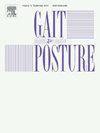Distinct hip–knee coordination patterns in individuals with hip osteoarthritis as measured by cyclograms
IF 2.2
3区 医学
Q3 NEUROSCIENCES
引用次数: 0
Abstract
Background
Hip osteoarthritis (HOA), involving cartilage degeneration and altered load distribution, disrupts gait biomechanics. While joint coordination plays a key role in efficient walking, dynamic inter-joint coordination changes across HOA progression remain underexplored.
Research question
Do inter-joint coordination patterns differ between healthy individuals and those with HOA? How does HOA severity affect inter-joint coordination, as analysed through hip-knee cyclograms and coupling angles?
Methods
Using a publicly available dataset, we analyzed 78 healthy individuals and 96 HOA participants, categorized into three subgroups based on Kellgren–Lawrence (KL) grade. The inter-joint coordination outcome measures included cyclograms perimeter, area, and coupling angle. ANCOVA (covariates: walking speed/weight/BMI) was conducted to examine differences in cyclogram area/perimeter between groups, while MANCOVA was performed to analyse differences in inter-joint coordination patterns between groups. Post-hoc comparison tests were performed where overall significance was observed using multiple t tests.
Results
Cyclogram area, perimeter, and coupling angle differed significantly between healthy and HOA groups (all p < 0.001), but not among HOA severity subgroups. Healthy individuals showed in-phase coordination pattern during mid-stance, whereas individuals with HOA displayed proximal coordination. In individuals with HOA, the coordination pattern shifted from proximal to anti-phase earlier than in healthy individuals during terminal stance and early pre-swing. No significant difference in coordination pattern during the swing phase was observed between healthy individuals and individuals with HOA.
Significance
Hip-knee coordination patterns may serve as a biomechanical marker of HOA-related gait dysfunction, offering a potential avenue for prompt intervention and management of the disease.
不同的髋关节-膝关节协调模式的个体与髋关节骨关节炎的测量环图
髋关节骨关节炎(HOA),涉及软骨退变和负荷分布改变,破坏步态生物力学。虽然关节协调在高效行走中起着关键作用,但HOA进展过程中关节间动态协调的变化仍未得到充分研究。研究问题:关节间协调模式在健康个体和HOA患者之间是否不同?通过髋膝环图和耦合角分析HOA严重程度如何影响关节间协调?方法使用公开数据集,对78名健康个体和96名HOA参与者进行分析,根据Kellgren-Lawrence (KL)等级将其分为3个亚组。关节间协调结果测量包括环线周长、面积和耦合角。采用ANCOVA(协变量:步行速度/体重/BMI)分析两组间环纹面积/周长的差异,采用MANCOVA分析两组间关节间协调模式的差异。进行事后比较检验,使用多重t检验观察总体显著性。结果环图面积、周长和耦合角在健康组和HOA组之间差异有统计学意义(p均为 <; 0.001),但在HOA严重亚组之间差异无统计学意义。健康个体在中位时表现为同位协调模式,而HOA患者则表现为近端协调模式。在HOA个体中,在站立末期和前摆早期,协调模式从近端转向反位相的时间比健康个体早。健康个体和HOA个体在摇摆期的协调模式无显著差异。髋关节-膝关节协调模式可能作为hoa相关步态功能障碍的生物力学标志,为及时干预和治疗该病提供了潜在的途径。
本文章由计算机程序翻译,如有差异,请以英文原文为准。
求助全文
约1分钟内获得全文
求助全文
来源期刊

Gait & posture
医学-神经科学
CiteScore
4.70
自引率
12.50%
发文量
616
审稿时长
6 months
期刊介绍:
Gait & Posture is a vehicle for the publication of up-to-date basic and clinical research on all aspects of locomotion and balance.
The topics covered include: Techniques for the measurement of gait and posture, and the standardization of results presentation; Studies of normal and pathological gait; Treatment of gait and postural abnormalities; Biomechanical and theoretical approaches to gait and posture; Mathematical models of joint and muscle mechanics; Neurological and musculoskeletal function in gait and posture; The evolution of upright posture and bipedal locomotion; Adaptations of carrying loads, walking on uneven surfaces, climbing stairs etc; spinal biomechanics only if they are directly related to gait and/or posture and are of general interest to our readers; The effect of aging and development on gait and posture; Psychological and cultural aspects of gait; Patient education.
 求助内容:
求助内容: 应助结果提醒方式:
应助结果提醒方式:


